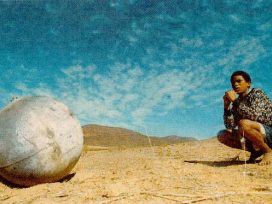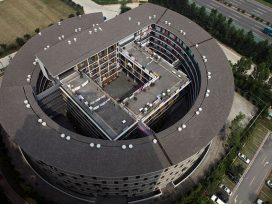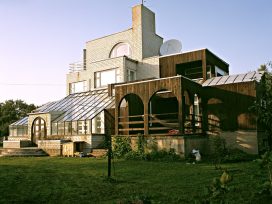In subtropical areas, the walls of buildings have always had the crucial function of protecting against heat. A look at traditional building typologies in subtropical regions shows that a comfortable indoor climate was achievable even without air-conditioning in earlier times. The Tulou structures in the Fujian province of southeastern China are a typical example of this.
By contrast, in present-day residential construction, the wall as part of the façade and building structure only seldom functions as a climate-regulating element; instead, air conditioners have increasingly been used in recent decades. The utilization of these appliances in hot-humid regions, and the related energy consumption has been enormous (fig. 1): in Hong Kong alone, a metropolis of seven million inhabitants, the use of air conditioners equates to energy consumption of 6.8 gigawatts annually.
A contemporary solution for this problem was attempted by URBANUS Architects with a residential construction project by the name of Urban Tulou completed in 2008, where the traditional Tulou typology was adapted to the urban context. Such construction projects illustrate the potentials offered by the wall as a climate-regulating element, as well as how procedures for creating novel wall structures are currently being developed and optimized today.
A specific architectonic arrangement of the walls based on the fundamentals of building physics could thus become a way of improving the climate of interior rooms in hot-humid regions. Wall elements are known to address a range of different purposes, for example, providing shade, arranging transverse ventilation, or converting temperature into thermal mass.
It makes sense to demand that exterior walls avoid overheating from solar radiation while simultaneously facilitate a natural ventilation of buildings in hot-humid regions. But which premises need to be considered so that the wall, in its quality as thermal mass, may optimally influence the comfort of interior spaces? The openings placed in walls must be specially designed to be capable of flexibly reacting to various exterior factors like temperature and air velocity. At the same time, residential development should allow for the basic needs of the inhabitants, such as for instance sufficient light, privacy, and open spaces outside.
How can these parameters be reached and what relevance do they have for the appearance of the building in terms of architecture and design? How can a holistic concept be developed that satisfies these criteria pertaining to form, function, and energy in a way that promotes a coherent, expressive visual identity? Answers to these questions may be found in two buildings in China: the three-hundred-year-old Chengqi Lou Tulou (1709) in the Fujian region and the contemporary Urban Tulou in Guangzhou (2008).
China as a climatic region
A humid, subtropical climate permeates the Southeast Asian conurbations. Building interiors should ideally have 50 per cent humidity and 22 degrees centigrade for a comfortable living environment, while the humidity outside is almost double and temperatures up to 35 degrees prevail. Such conditions make the utilization of air conditioners a standard practice for regulating interior climate within homes. These electric systems, which emit warm air, only serve to further heat up the congested urban areas. ‘Air conditioners … may cool one’s own home … but they make urban environments even hotter in the process. In the warmer regions of the United States and in parts of Eastern Asia, the massive use of air conditioners means that the nights do not even cool down. And so the people there are sitting in self-made heat traps.’
The urban heat island effect comes into play, where air conditioners heat up the already overheated (due to an increased sealing of surfaces) urban spaces even more, since the construction mass serves to accumulate heat and can no longer cool off at night. Furthermore, the efficiency of an appliance that solely works to cool air uses two-thirds more energy as compared to the water-based heating and cooling systems commonly found in Europe, for water is considerably more efficient in transferring warmth or coolness.
In addition to these disadvantages to air-conditioning systems – high energy consumption, poor efficiency, and acceleration of the urban heat island effect – even more negative aspects can be cited. For example, during the air-cooling process, condensation water is released in addition to heat. Since it is rare for an air conditioner to deflect moisture in a controlled way, this water haphazardly drips down the exterior façade, and such perpetual dripping is perceived as an unpleasant sound, especially at night. The extra sounds produced by the engines running also cause the noise level to rise even higher.
The 150 million residents of the southeastern coastal area of China require immense amounts of energy each year to cool their homes through air-conditioning. Each household boasts two to five air conditioners, and office buildings are likewise solely cooled with temperature-control units – for a comfortable indoor climate is stipulated in workplace guidelines. It may thus be assumed that on average each person uses 10 000 KWh of electricity per year for cooling. The enormous energy demand in China is especially apparent when viewing the chart on the energy expenditure of air conditioners in subtropical regions.
At present, half of China’s population resides in cities. This equates to the situation in Europe prior to industrialization. According to statistical projections, the urban population of the world will nearly double by the year 2050, rising from 3.5 billion to 6.3 billion. It would follow that the energy demands for cooling will likewise nearly double by 2050. Assuming that urban residents will not want to relinquish their air conditioners, this growth forecast represents a major challenge for energy production and climate balance.
The potentials of the wall as a climate-regulating element
The quality of the indoor housing climate is defined based on the perception of comfort and on the relationship between temperature level and radiant intensity. Here the question arises as to which interior climate is achievable without air-conditioning in subtropical regions and which criteria must be fulfilled in the process. At the conference Sustainable Smart Cities held at Graz University of Technology, Edward Ng responded to the question of the feasibility of using natural ventilation in subtropical regions like Hong Kong instead of air-conditioning: ‘You have to stop the sun from shining into the interior to prevent an increase in temperature, … windows need to be opened to facilitate cross ventilation. … It is important to open windows in a clever way.’
So a comfortable interior climate is indeed attainable in subtropical regions without using air conditioners. And it can be improved through ventilation alone, even when air temperature and humidity remain constant: the perceived temperature, that is, the feel of humidity and temperature, changes when moving air is present, depending on its velocity. Air circulation plays a significant role in fostering well-being within living spaces. The openings in the walls must be regulated differently depending on the various temperature levels and wind speeds using distinct cross-section vents where air can flow in and out. A further important aspect contributing to a sense of comfort is radiant intensity. Radiant heat occurs outside when, for example, surfaces are heated by the sun. Inside buildings, massive wall elements either emit or absorb radiant heat or coolness. This means that surface temperatures and the activation of storage mass also play an essential role in creating comfortable interior spaces. In order to store cooler temperatures, the material must exhibit high density; and to ensure the correct transfer of temperature (phase shift), the thickness of the exterior walls is decisive in ensuring that the stored coolness can be transferred to the interior spaces within a certain temporal cycle.
The Traditional Tulou
The three-hundred-year-old Tulou roundhouses in the Fujian region of southeastern China harness the potential of the wall for improving the climate of interior spaces (fig. 2). Though at the time of their construction no technology for cooling interiors existed and the claim to comfort was clearly geared to different standards than today, simple building-physics fundamentals and intelligent spatial arrangements were used to generate a comfortable housing climate for the Tulou inhabitants.
The Tulou structures were built of earthen materials found in the nearby environment (Fig. 03). Due to the static load-bearing capacity of the Tulou buildings, which have up to four stories, the exterior walls were designed to be 1 to 1.5 meters thick. These massive cob walls serve as temperature buffer zones: during the hot summer, heat is stored in the walls, but thanks to their very broad diameter – and thus high storage capacity – it takes a long time for the heat to move from the outside in. In contrast to thinner concrete walls, where it is possible for temperature transfer to function within one day/night cycle, the phase shift in the Tulou takes place over the course of the seasons. Variations in temperature, which happen within the wall as delayed temperature waves and are emitted into interior space, are contingent on the thickness of the layers within the wall and its thermal diffusivity.
In summertime, high temperatures are not conducted inward so that interior space remains cool; not until the colder seasons arrive does the summer warmth stored in the walls reach the inside.
While the massive wall tapers off toward the top, its lower portion displays the greatest thickness, which serves to optimize contact with the ground and thus also to the earth below. This extensive bearing with direct contact uses the temperature of the earth as a passive way of cooling mass: six meters below the surface, the earth has a consistent temperature year-round, which usually also means that it deviates from the more strongly varied air temperature. The earth’s temperature – cooler in the summer and warmer in the winter – rises up into the wall mass and is thus able to passively activate the building (fig. 4).
The Tulou building’s exterior shell is plastered with a thin layer of calcareous-clay. The light chalky color reflects solar energy input and thus inhibits an overheating of the wall. Furthermore, this calcareous coating protects against outdoor weathering, such as driving rain or humidity. The interior walls remain unsealed, which allows the earthen material to absorb moisture from the inside and release it again when needed: the cob wall facilitates balanced moisture conditions to the inside, which translates into a comfortable indoor climate.
With its introverted form and massive, closed exterior walls, this dated building type offers its inhabitants protection and a sense of security (fig. 4a). The circular construction improves material efficiency: with a round exterior wall, less building material (in relation to built spatial volume) is needed as compared to an orthogonal typology. The housing units are arranged adjacently in the round building form, with each oriented both to the inner courtyard and to the outside. The housing units span right through the building – accessible via the inner arcades – and render transverse ventilation possible with small, square window openings (one by one meter square) in the exterior wall and also openings toward the courtyard (fig. 5). These openings in the walls are specially designed to be able to flexibly react to diverse external factors like temperature and air velocity. This has been solved through a simple but clever mechanism whereby an opening in the courtyard-side wall allows the flow of air to be controlled: two sequentially arranged wooden grids may be shifted within one window frame. As such, the window can be manually adjusted with a simple gesture of the hand to accommodate either a small or a large cross-section vent for the air to flow through (fig. 6).
The Urban Tulou
The Urban Tulou housing complex, designed by architects at the URBANUS firm in Shenzhen to be built in the subtropical town of Guangzhou, has greatly limited the use of air conditioners (Fig. 07). This has been achieved through a conceptually homogeneous interplay between façade, building form, layout, and individual wall elements. As a special pilot project, the structure reflects on the principles of local, traditional construction to transform them into contemporary architecture. The URBANUS architects reworked the conventional housing typology of the Tulou and thus developed a new, functional, modern architectonic concept. The Urban Tulou was realized in 2008 in the province of Guangdong and contains 273 studio apartments, apartments, and dormitories for low-income residents. It is fascinating how the wall as a climate-regulating element is able to fulfill the demands placed on wall openings here to ensure shading and facilitate penetrability during transverse ventilation. Also notable is which design-related and external manifestation is possible in order to guaranteeing functional qualities like open spaces and privacy.
Facade
Through their interaction, the wall layers of the façade form an element that simultaneously separates and connects, thus creating a kind of filter. The first layer, the façade shell, facilitates light and air permeability and, at the same time, also visual privacy, protection against strong rain showers, and security. The interstitial space serves as a shaded air layer designed to lower temperature and as a place to linger on the outside of the adjacent, actual exterior wall. On the one hand, this airtight wall serves as a connector to the building’s interior through its significant glazing; on the other, it fosters a connection between the interior and exterior walls with massive concrete elements, which is necessary for the utilization of the thermal mass.
The façade modules used in the primary construction consist of prefabricated elements (fig. 8) made of fiber-reinforced concrete on the outside shell and wooden sun-protection panels on the side facing the inner courtyard (fig. 9). Both exterior facades are porous, that is, furnished with small openings. This building casing provides good shading and makes it possible for air to penetrate the building through its many small openings. The result unites the obvious influence of Chinese building traditions and the fulfillment of the demands placed on contemporary living. To this end, the motif of the traditional Chinese lattice window has been adopted. It originated during the Ming and Qing Dynasties between the thirteenth and eighteenth centuries. The wooden lattices used in windows, doors, and even walls represent an element typical for traditional Chinese architecture, one to which special artisan-aesthetic attention has been devoted in China (fig. 10). Yet the actual meaning behind such latticing is purely functional, for it served to provide the house with shading and – through its fragmented vents – also ventilation. These are functions also taken on by the concrete elements in the exterior façade of the modern building introduced here. At the same time, the architects have cultivated the qualities of the concrete to design an adaption of traditional lattice windows.
The façade suggests a uniform structure from both the inside and the outside, and in terms of form, it displays a homogeneous appearance. The concrete adaptation of the traditional lattices is seen in the delicate elaborations of the wood-panel structure. They are attached to each respective housing unit and can be opened in their entire height up to the ceiling. The hinged wooden doors are latticed with vertical wooden struts. An important design element here is focused on achieving the necessary door stability without additional elements, and thus on making the traditional origins visible in a minimalist way. The wooden struts coming from the top and the bottom overlap in the middle range and ensure the required stability on their own.
The exterior façade allows for the complete opening of the outside shell of the building to the inner side, which means that it is hence protected from the sun but also from unauthorized entry. Since such a “second façade” is not discernible from the outside, it may be generously structured. The glass doors can be freely and widely opened, which makes the interstitial area part of the living space. This shaded and well-ventilated exterior area gives the residents a private place to spend time, but it is also used for banal yet essential activities like drying laundry.
The traditional Tulou is completely closed from the outside with the exception of a few window openings and the front door on the ground level. While the new Tulou is meant to retain this closed character and thus the traditional identity of the old form, its modern facade is breathable and, as such, provides the residents with natural ventilation and lighting, as well as a higher quality of living that includes areas for spending free time. But not only the nature of the exterior facade is decisive in fostering comfort without air-conditioning. Also significant is the positioning of the exterior and interior walls to facilitate transverse ventilation, as is the employment of thermal mass and the arrangement of the buildings themselves. In other words, the whole architectural layout and building structure is relevant to the climate-regulating element of the wall.
Building Structure
The round form of the Urban Tulou building addresses the traditional Tulou typologies, both in terms of form and function. The round structural form means it does without a directional orientation, with the wind being distributed through the interior of the building regularly. The wind arrives from a southeasterly direction during four months of the year, and the rest of the year from a northeasterly direction. The circularly arranged housing units are furthermore designed to receive a great deal of fresh air from the courtyard side. Though the facade shell as porous concrete membrane does not extend into the building interior, the concept of the housing units spanning across the building has been executed in each building section (fig. 11). From the inside as well, each housing unit has private leisure space to one side and a partially open access area on the other side. This housing typology and the continuation of the wooden elements are the golden thread of the design concept, which permeates the building from the outside in or vice versa (fig. 12).
The architects modified the circular building volume by continuing the body of the structure toward the inside and elongating it to create a spiral made of four orthogonal bends (Fig. 13). Emerging in the inside spaces as a result are five inner courtyards where a light circulation of air is always present – even when no wind is blowing outside of the building. A variation in number of stories for each section of the building here results in gradations of height, thus making it possible for wind to circulate.
An essential modification of the old Tulou is the partial removal of the elevated basement level. Now air can enter the building along the ground floor and flow upward to bring cool air into the apartments. Further recesses can be found in the upper stories and are used as common areas. The stairwells evince an open design to enable air to stream inward here as well (fig. 14). The basement itself, which is used as a communal room for storing bicycles, projects a meter out of the earth’s surface and is open to both sides. This, too, allows wind to flow in and out for cooling the space (figs. 15-16). Building elements that are in contact with the earth benefit from geothermal ground cooling during the summer: coolness is emitted from the walls and base plates into the air outside to cool it down, a process that has been substantiated by measuring the air and surface temperature of the various wall elements. As a result, the inner courtyards experience enhanced ventilation thanks to the discrepancies in air temperature. The infiltrating air is cooled down through shading and the storage mass of the concrete, and upon warming again it rises up. This generates a thermal and wind-induced lift in the inner courtyards.
Since the housing units are arranged to face the loggia and the access corridor respectively, transverse ventilation is ensured. The air is left to flow unimpeded through all parts of the apartment being that they are arranged adjacently using cross-wall construction. To facilitate transverse ventilation, the architects conceptualized numerous fanlightwith sliding openings along the circumferential arcades. With such sliding mechanisms, the fanlight and the sliding glass doors facing the loggia are excellently suited for controlling the intake of air.
The exterior facade shell uses shading to prevent solar-induced overheating of the supporting concrete wall behind. The latter is used as a cooling mass. The material of this concrete wall exhibits high density and therefore good storage capacity. So as to guarantee the correct transfer of temperature (phase shift), the exterior wall’s layer thickness is designed to transfer the coolness stored during the night into the room interior over the course of a twelve-hour cycle (figs. 17-18).
Measurements of the air and surface temperature of the walls in various Urban Tulou housing units has provided the following results: in order to achieve an optimal comfort level, it is necessary to alternate between transverse ventilation and closed windows since this enables a utilization of the radiant cooling of the concrete walls. The indoor climate can therefore be regulated by the inhabitants accordingly and is thus dependent on user behavior.
Furthermore, there is a vertical air shaft located in between all adjacent housing units. With the help of this chimney, all bathrooms are deaerated in a natural way: the sun rays hitting the roof heat up the cover of the chimney outlet and the air situated beneath. This generates a stack effect whereby the cooler air is literally pushed through the bathrooms into the apartments (fig. 19). To support this suction effect, residents may open the door to the bathroom and those to both the loggia and the access ends of the apartment.
The Urban Tulou offers its dwellers a pleasant housing climate while doing completely without air-conditioning units. The building shape, the facade, the layout arrangement, and also the treatment of individual wall elements have developed based on the local climatic conditions. A typology has emerged where walls replace air conditioners. An essential quality of the project is the harmonious interplay between design parameters that are based on fundamentals of form, functionality, and building physics.
Optimization Potential
The insight gained from analyzing the Urban Tulou might serve as a basis for developing new buildings. The following aspects illustrate points of origin for potential optimizations, and thus also for the development of new typologies.
Shading Elements in the Courtyard Area
The wooden wall elements found in the inner courtyards do not suffice in providing adequate shading for the sliding glass doors. Other sliding elements should complement the existing ones to inhibit direct insolation and a related overheating of the indoor rooms. Such wooden lattice elements would need to be placed in front of the steel balustrade because steel as a heat conductor is known to excessively heat up when subject to direct sunlight. The measuring of surface temperature yielded 37 degrees centigrade – a temperature that could lead to injury if the steel balustrade were touched.
Passive Cooling of Air between the Supporting Walls
The passive cooling of air due to the vertical utility shafts at the front end of the housing units might rather be run parallel to the tapered supporting walls separating the units. The ventilation shaft could thus be narrower and more elongated, which would serve to expand the contact between cool air and thermal mass, that is, along the entire expanse of the wall. The thermal mass would then cool the interior areas considerably more efficiently.
Controlled Ventilation in the Basement for Utilizing Storage Mass
The basement areas are utilized for geothermal ground cooling whereby the storage mass of the building elements comes into contact with the earth. In the case of Urban Tulou, this carries the advantage of the air being cooled down during the day so that it can flow into the inner courtyards. The openings here are permanently ajar, yet a possibility for precisely controlling the entrance and exit of air would be of advantage: by reducing the air passages during the day, the efficiency of the thermal mass could be heightened. Attuned to the air velocity present outside, the air change should be adapted so that enough radiant cooling is emitted from the mass into the air that the temperature difference and resulting thermal conditions are effective. Moving wall openings sometimes operate with computer-driven, electronic mechanisms. Here a contraption could be used to self-regulate in accordance with external climatic factors like wind strength (self-closing shutters) or temperature (bimetals).
Conclusion
Interviews with residents living at the Urban Tulou have shown that the existing openings in the walls are not sufficient during midsummer nights to maintain the necessary air volume for transverse ventilation. This problem cannot be easily solved by enlarging the existing flap-type openings because static standards and the load transfer of the concrete cross-walls only conditionally allows for larger wall openings. Therefore, the development of a wall structure that combines qualities like load transfer, thermal activation, and air permeability must be considered. Light-permeable concrete already exists (fig. 21): it is produced of fine-grained concrete and fiberglass matting and acquires the stability of conventional concrete. Air-permeable concrete might be similarly achieved by horizontally layering small tubes.
A further approach might be to develop an entryway door element that could function like the aforementioned controllable opening elements in the traditional Tulou. With this longstanding technology, the wooden strut guarantees security and steerable air intake. It would be a challenge to invent a new door element that likewise meets the demands of modern sound insulation.
In addition to the already mentioned methods of natural ventilation, passive cooling, and the utilization of storage mass and phase shifting, there are several further possibilities for optimizing energy consumption that could support efforts to do without air-conditioning, such as adiabatic cooling and evaporative cooling. Moreover, it should be examined whether the process of moisture storage might find application in subtropical regions. The challenge lies in adapting these technologies to the climatic conditions of the subtropics without expending considerable technical effort.
However, this knowledge does not presuppose that planned new buildings should be conceived in the same way as the Urban Tulou. Rather, the Urban Tulou project evidences how necessary design parameters need not be dependent on external appearance – for instance, the building form in its fragmented arrangement of building volumes, which is necessary for optimally channeling wind currents within the complex. In the case of the Urban Tulou, these aspects are purposefully not shown to an advantage, for the building actually appears more formal than holistic since it is girded with the exterior facade shell.
Various time-dependent factors change with each individual project: location, building site, wind direction, and specific residential use are not constant criteria; inhabitants and building contractors have different demands and needs; and budget sizes vary. These factors and criteria must be combined with the formal, functional, and building-physics-related demands in the overall design process and, as such, should result in entirely new building concepts.
Richard Hassell, founder of the WOHA architectural firm in Singapore, describes his design approach as follows: “In the developed world, buildings are technologically refined with high-performance facades and central control and monitoring. Our preference in the developing world is to use less technology and more architectural means to achieve sustainable and easy-to-maintain tall buildings; for instance, a sunshade or balcony, rather than high-performance glazing, and windows that open rather than a computer-controlled ventilation system.”
Our analysis of the Urban Tulou shows that we must look beyond the mere development of new, intelligent, and energy-saving high-tech facade systems in seeking solutions to these problems. The solutions may instead lie in a paradigm shift: in developing new architectural concepts that display a diligent and well-thought-out treatment of the wall as an option for regulating climatic conditions while forgoing the use of energy-consuming air conditioners. The result of this exploration of the Urban Tulou offers a fundament for facing the challenge of establishing new housing alternatives in the subtropics. Ultimately, architects are now called upon to introduce building contractors and clients to new and daring housing typologies.






